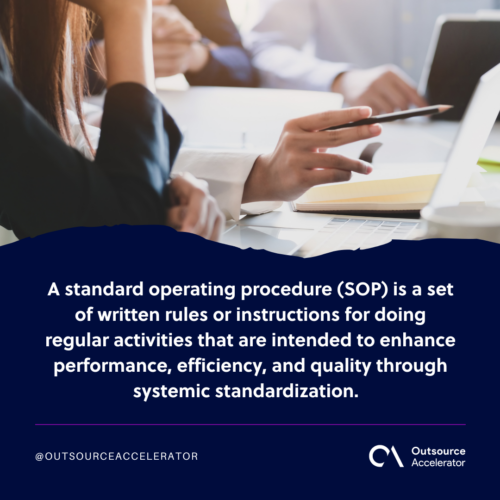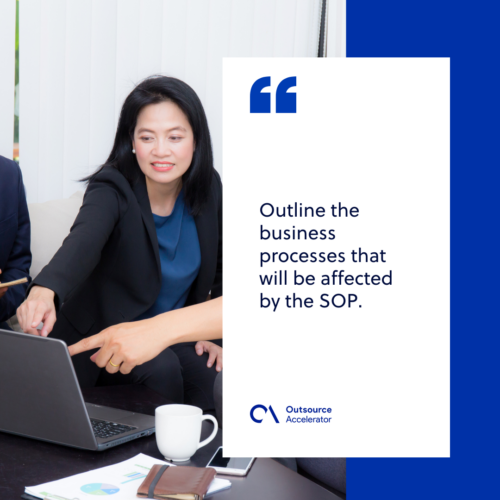Standard Operating Procedure (SOP)
Definition
What is the standard operating procedure (SOP)?
A standard operating procedure (SOP) is a set of written rules or instructions for doing regular activities that are intended to enhance performance, efficiency, and quality through systemic standardization.
It’s much more comprehensive than a standard policy document. The primary distinction of standard operating procedure (SOP) is it provides a precise explanation of what needs to happen to guarantee a certain process works successfully.

Why is a standard operating procedure important?
Documenting standard operating procedures is essential since it enables companies to organize their operations, maintain teammates and other stakeholders on the same page at all times, and proceed in a unified, cohesive manner.
Let’s explore a little deeper into what generating SOP documentation can offer to your business.
Ensures adhesion to best practices
Commitment to quality standards in all organizational activities is no longer a recommendation, but a requirement with a standard operating procedure (SOP) in place.
Creating SOP gives the team members not just a direction to aim for, but also a clearly defined map to assist them along the journey. This increases the likelihood of a positive outcome in a particular circumstance while having to reduce the likelihood of experiencing any barriers along the way.
Guarantee consistency
Creating a standard operating procedure (SOP) improves your organization’s capacity to perform as it functions to conduct business with machinelike efficiency. Following SOP guarantees that your staff always knows the correct path to follow and will always take it when necessary.
Enables proper onboarding and training
By precisely establishing standard operating procedures in your business, you will make it easier to recruit and teach your entire team best practices in certain circumstances.
Since one of the objectives of developing an SOP is to try every possible course of action to achieve something in terms of dependent conditions, you’ll have a greater understanding of what these prospective situations are, allowing you to teach your employees how to manage effectively.
How to write a standard operating procedure
Organizations must constantly consider each step included in an SOP, no matter how minor it seems. System Requirements should clearly state what activities must be done to minimize errors, inefficiencies, and unavailability.
Step 1: Collect data
First, the business should gather information on the technique, process, and activity. An employee in charge of carrying out the task should offer an accurate definition of the procedure that they want to regulate.
At this point, the purpose of the standard operating procedure (SOP) should also be defined.
Step 2: Choose a format
Organizations that have previously established standard operating procedures might rely on previous templates rather than creating new ones. Those creating entirely new SOPs or business processes are determined by their business requirements and operations.
Step 3: Involves staff
The duties are carried out by the employees. When establishing SOPs, it is vital to know client feedback. This ensures that they’re on the board and makes it easier for the SOPs to be implemented.
Employee engagement, according to thebalancecareers, is the “foundation of successful change management.” It’s also a good method to ensure that all of the required duties are covered.
Step 4: Define your scope
The standard operating procedure (SOP) purpose and relevance should be specified. Outline the business processes that will be affected by the SOP.

Step 5: Identify target client
The organization should determine the SOP audience at this point. Create the SOP with this audience in mind. The factors to consider include familiarity with the organization, standard methods, terminology, knowledge level, language, and understanding abilities.
When defining target users, consider their level of expertise in completing the stated activities, as well as their roles and responsibilities if they are distributed across different teams and responsibilities.
The identification of target users also contributes to the allocation of appropriate roles and obligations in the SOP document.
Step 6: Develop and evaluate
Develop a draft of your SOP to include the elements mentioned above while you may still have questions about the most effective way to write SOPs.
Then, send the SOP to the team members for evaluation after you’ve finished writing it. Members should put the SOP to the test to determine if it achieves the desired result. In addition, SOPs ensure technical consistency and simplicity of implementation.
To enhance the final document, including appropriate recommendations and revisions. After all, stakeholders have acknowledged and authorized the paper, it should continue to the final stage.
Step 7: Implement
After the SOP document has been approved, it should be given access to the appropriate staff for implementation. Employees should be made to learn and ready to carry out the SOPs.
Management should keep an eye on compliance, hold people accountable, and analyze results. Reviews can be done regularly to record changes to present procedures or to enhance them.







 Independent
Independent




